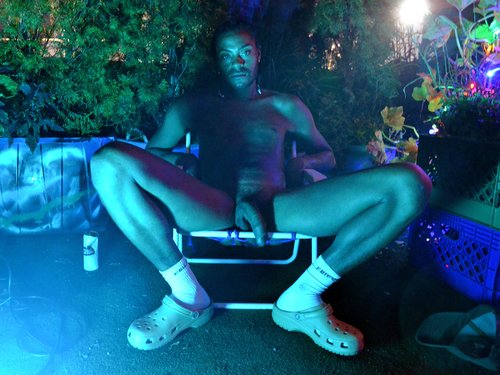A queer photography exhibition that explores the intersections of intimacy, desire, and identity in the contemporary landscape of escalating culture wars, with state-sponsored, religious and corporate homophobia and censorship on the rise on both sides of the Atlantic.
Text by Gerardo Vizmanos
Romantic Ideal, curated by Slava Mogutin, opened in New York City last May 1st, featuring a group of queer artists. At REDLIST, we’re proud to present this special exhibition that brings together a community of artists connected by friendship. To accompany it, I´ve written a text reflecting on the meaning of friendship for this show.
Friendship is Political
Romantic Ideal, curated by Slava Mogutin and featuring a group of queer artists, holds a special significance for me in terms of friendship (the theme of our magazine REDLIST 5). It’s friendship that brings together artists who are part of a shared community. Beyond the complexities of queer love, desire, and identity explored in the exhibition, friendship, and the radical act of reclaiming its meaning, feels essential to building a sense of belonging.
Exhibitions like Romantic Ideal, curated from within the community, connect to a long lineage of queer resistance, that has shown how friendship can be a powerful political force.
In the 1970s, many queer people migrated from hostile environments to cities like New York, San Francisco, London, or Amsterdam, seeking not only freedom, but community. There, they could finally find others with whom to share, often for the first time, not only their desires but also their experiences of repression. In those encounters, the private became political, not simply by becoming public, but by becoming shared. The truly political act was to build an affective community from those experiences. friendship turned individual experience into collective transformation.
This exhibition curated by Slava Mogutin connects with a long tradition that weaves together activism, friendship, and art. During the AIDS crisis, this affective dimension became essential. Networks of friendship turned into material structures of care, support, and resistance in the face of institutional neglect. As David Wojnarowicz expressed, “I want someone to hear what I have to say. And maybe then, maybe I can sleep at night. Maybe then I can be calm. Maybe then I can breathe.” This line distills a politics of friendship that is not just personal, it is profoundly political.
As Jacques Derrida said in The Politics of friendship, “There is no politics, not even the possibility of thinking the political, without the experience of friendship, without the desire for a coming community sustained by a bond that escapes the logic of the contract.”
Today, as hate speech and censorship continue to spread around us, it is also worth remembering the importance of friendship in the words of Michel Foucault’. “Perhaps the most urgent political challenge for homosexuals is not to discover who they are, but to determine with whom they can form relationships. The possibility of creating new relational ties is what makes us dangerous.”
Friendship has traditionally been a link between art and protest. Historical exhibitions such as Silence=Death, Let the Record Show (1987), (curated by William Olander) or Witnesses: Against Our Vanishing (curated by Nan Goldin in 1989), are best understood not just as public acts, but as expressions of a community of friends who sustained one another through grief and resistance. They were visual letters exchanged between affections that became political slogans.
Today, Romantic Ideal by Slava Mogutin is not just another queer art show, it is a reminder that the visibility of a community also comes through friendship. In this exhibition, the intimate becomes political precisely because it is supported, shared, and lived within an affective network that is, in itself, a form of revolution.
Text. Gerardo Vizmanos
Romantic Ideal is on view until August 31, 2025. The Bureau of General Services—Queer Division, @bgsqd
The LGBTQ+ Community Centre,
208 W 13th Street, NYC 10011,
Featured Artists
Alejandro Ruiz (US-Mexico) @alexandroruixx
Ben Prince (US) @benprinceusa
Benjamin Fredrickson (US) @benjaminfredrickson2
Brian Kenny (US) @briankennny
Bruce LaBruce (Canada) @brucelabruce
Cameron Lee Phan (Vietnam-US) @cameronleephan
Carter Peabody (US-Mexico) @carter_pbd
Donovan Quiroz (Mexico) @dnvn1
Francis Schichtel (US) @francis_schichtel
Gerardo Vizmanos (Spain-Germany) @gerardovizmanos
Gio Black Peter (Guatemala-US) @gioblackpeter11
Jan Wandrag (South Africa-US) @janwandrag
Łukasz Leja (Poland-US) @lukaszleja
Luke Abby (UK-Germany) @lukeabby
Matt Lambert (US-Germany) @dielamb
Miguel Villalobos (Venezuela-US) @miguelvillalobosnyc
Paul Mpagi Sepuya (US) @pagmi
Quil Lemons (US) @quillemons
Robert Flynt (US) @robertflyntfoto
Ross Collab (US) @rosscollab
Scott Hug (US) @mr._hug
Slava Mogutin (Russia-US) @slavamogutin
Stanley Stellar (US) @stellar.fse
Stuart Sandford (UK-Mexico) @stuartsandford
Tom Bianchi (US) @tombianchi
Tony Solis (Mexico) @tonysolisyosoy
Tyler Matthew Oyer (US) @tmostudio
Victor Jeffreys II (US) @victorjeffreysii
Gerardo Vizmanos
















